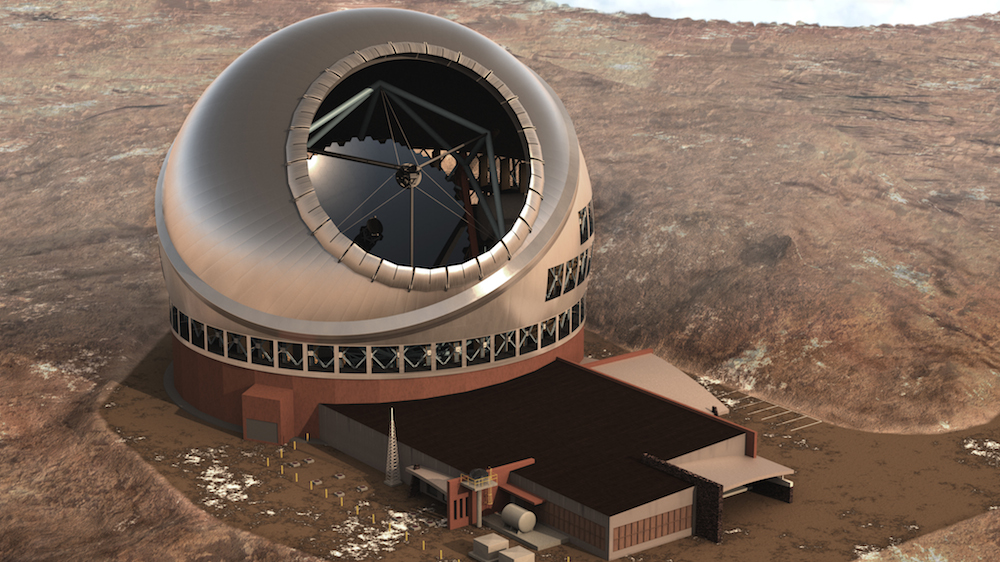Giant Galaxy-Spying Telescope Set to Break Ground in Hawaii

A giant, 100-foot-diameter (30 meters) telescope has been green-lighted for construction on the island of Hawaii.
The Hawaii Board of Land and Natural Resources gave approval on July 25 for construction to begin on the Thirty Meter Telescope (TMT), a massive observatory on the summit of Mauna Kea, said representatives for The TMT Observatory Corp., a collaboration of universities involved in the telescope's development.
"TMT has worked for many years to design an unprecedented telescope, but also to work with the community to incorporate respect for Mauna Kea in our stewardship," Gary Sanders, project manager for TMT, said in a statement. "It is an honor and a privilege to now begin building our next-generation observatory in so special a place." [In Images: Hawaii's Thirty Meter Telescope]
When it begins operations, TMT will enable astronomers to explore objects inside the solar system, stars throughout the Milky Way and neighboring galaxies, and forming galaxies at the farthest edge of the observable universe.
Since the site was chosen, the telescope's construction has been controversial among native Hawaiians, for whom the volcano represents sacred ground.
Nevertheless, the first phase of construction is scheduled to begin later this year, on a mountain that's host to other world-class observatories, including the twin 33-foot (10 m) Keck telescopes. The proposed telescope would be three times the size of each of the Keck telescopes.
The TMT Observatory Corp. was launched in 2003 by the Association of Canadian Universities for Research in Astronomy (ACURA), the California Institute of Technology (Caltech) and the University of California.
Get the world’s most fascinating discoveries delivered straight to your inbox.
The observatory's current members include Caltech, the National Astronomical Observatories of the Chinese Academy of Sciences, the National Institutes of Natural Sciences in Japan, and the University of California. India and Canada are associates, and are expected to become full members later this year and in 2015, respectively.
The construction site will be graded in preparation for a dedication ceremony in October. Meanwhile, TMT's international partners have already begun work off-site.
China is developing the telescope's main mirror system, lasers, laser guide star systemsand other components. (A laser guide star is an artificial star for removing atmospheric blurring.)
Project collaborators in Japan have produced 60 mirror blanks — mirrors that have not yet been polished to their final form — that will become part of the telescope's enormous 100-foot (30 m) primary mirror. The design of the telescope structure itself is nearing completion, a Japanese TMT board member said.
Project collaborators in Canada are finalizing the design of the telescope's adaptive optics facility, and have completed the telescope's enclosure design, a Canadian TMT representative said.
Meanwhile, India is building prototypes of the TMT's primary mirror assembly, as well as mirror actuators, sensors and support systems.
Three instruments are also being developed with help from all of the TMT partners, in preparation for the observatory's "first light."
TMT still faces some obstacles, however. As of late February, the observatory was only 83 percent funded, and a couple of key partner countries have not yet signed on.
Construction of the TMT is expected to create about 300 full-time jobs, and the observatory's operations are expected to employ a staff of about 120 to 140 people, TMT representatives said. The staff "will be drawn as much as possible from Hawaii Island's available labor pool," they added.
The Gordon and Betty Moore Foundation has donated $141 million so far to fund the design, development and construction phases of TMT, according to the observatory.
Follow Tanya Lewis on Twitter and Google+. Follow us @livescience, Facebook & Google+. Original article on Live Science.



